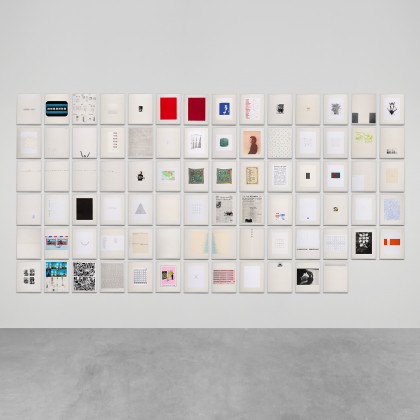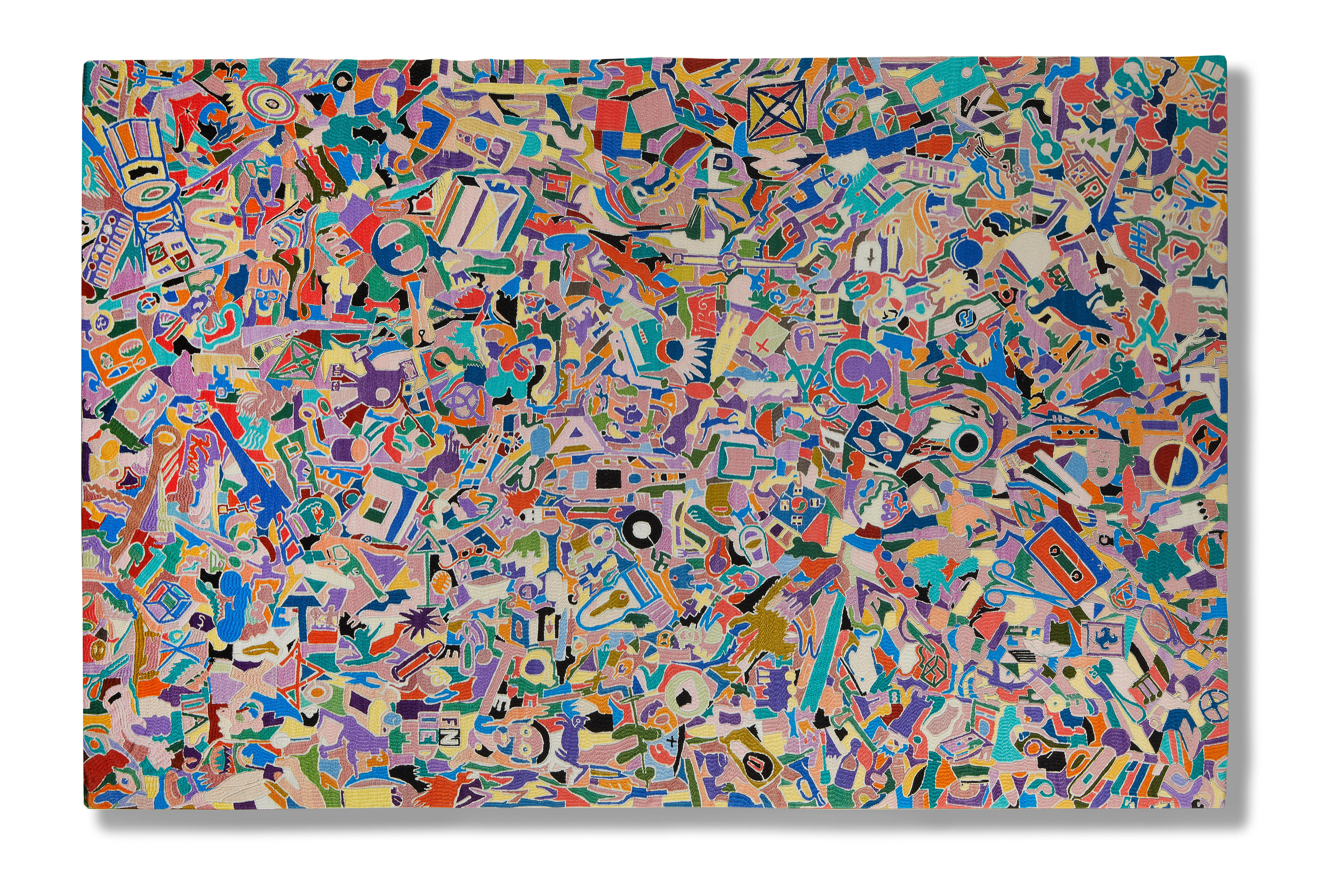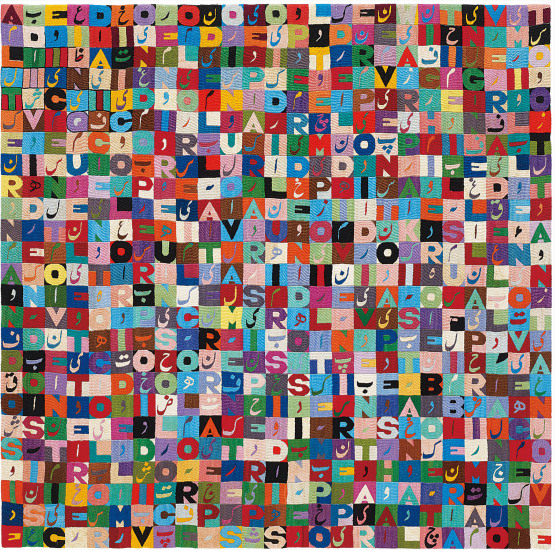Alighiero Boetti Mappa (planisphère) 1983 Embroidery on canvas. 44 x 69 in. (111.8 x 175.3 cm.) Embroidered “Alighiero Boetti” lower left. This work is accompanied by a certificate of authenticity from the Archivio Alighiero Boetti listed as no. 1689.
Provenance Steve O'Hana, Geneva Exhibited Paris, Tornabuoni Art, Alighiero & Boetti, March – June, 2009 Literature A. Sauzeau-Boetti, Alighiero & Boetti, Catalogue d’exposition, March 19 – June 5, 2010 Catalogue Essay To my mind, the work of the embroidered map represents the supreme beauty. For these works, I made nothing, selected nothing in the sense that the world is made the way it is and I have not drawn it; the flags are those that exist anyway, I did not draw them; all in all, I have made absolutely nothing. Once the basic idea is there, the concept, then everything else is already chosen. ALIGHIERO BOETTI (Alighiero Boetti quoted in Gagosian Gallery, ed., Aligheiro e Boetti, New York, 2001, p. 25) Alighiero Boetti working from his studio in Rome, designed tapestries such as the present lot, Mappa (planisphère), 1983, that present beautiful and intricate varieties of layer upon layer of silk threads, color and, political geography. The artist employed local Afghan women to embroider the fabrics, and their deliberate workings appear throughout this piece, broadening the spectrum of texture and association. In this case, the individual hands of the artisans at work lay bare the unique history of the fabrication process of the composition as a whole. They are a collage of infinite changing patterns of our global structure. Alighiero Boetti was an autodidact. Following his first exhibition in 1967, Boetti become synonymous with the Arte Povera movement, a term coined by the art critic Germano Celant to describe, in one part, art which takes its form from our raw materials at hand. Boetti was interested in the influence of philosophy and alchemy on the world, and the interplay of the connected traditions of the West and East in modern day. He sought out an art form which by technique erased his own hand in the production, although it is his very concept which creates the alluring testimony to the unique time and place from which they derive. Among the most widely known works by Alighiero Boetti are the embroidered maps of the world, from which the present lot is an outstanding example. They derive from conceptual drawings created between 1967 and 1971. In September 1971, Boetti took his first preliminary drawing to Afghanistan. Once the artist specified the colors of the threads to be used, four women then worked simultaneously on the embroidery, which, depending on the format, would take between one to two years to finish. The production of these embroidered pictures, an elaborate process, continued until the artist’s death, as they were a focal point for Boetti during his career. “From the very outset of his career as an artist, Alighiero tried to find an artistic form suitable for expressing the fundamental structures of the world which he discerned in appropriate aesthetic terms”, writes Rolf Lauter, “When the works were in the realisation phase, Alighiero often resorted to a dialogical communication system between the artist, on the one hand, and collaborators, assistants and outside parties handling the work, on the other.”The production of these embroidered pictures, an elaborate process, continued until the artist’s death, as they were a focal point for Boetti during his career. “From the very outset of his career as an artist, Alighiero tried to find an artistic form suitable for expressing the fundamental structures of the world which he discerned in appropriate aesthetic terms”, writes Rolf Lauter, “When the works were in the realisation phase, Alighiero often resorted to a dialogical communication system between the artist, on the one hand, and collaborators, assistants and outside parties handling the work, on the other.” The present lot, Mappa (planisphère), is a visually rich showcase of Boetti’s most popular artistic production, and with reason. The vibrant colors of the ocean, demarcated with the vivid white and black border of Persian script on the sides and Italian on the upper and lower margins, highlig
Alighiero Boetti Mappa (planisphère) 1983 Embroidery on canvas. 44 x 69 in. (111.8 x 175.3 cm.) Embroidered “Alighiero Boetti” lower left. This work is accompanied by a certificate of authenticity from the Archivio Alighiero Boetti listed as no. 1689.
Provenance Steve O'Hana, Geneva Exhibited Paris, Tornabuoni Art, Alighiero & Boetti, March – June, 2009 Literature A. Sauzeau-Boetti, Alighiero & Boetti, Catalogue d’exposition, March 19 – June 5, 2010 Catalogue Essay To my mind, the work of the embroidered map represents the supreme beauty. For these works, I made nothing, selected nothing in the sense that the world is made the way it is and I have not drawn it; the flags are those that exist anyway, I did not draw them; all in all, I have made absolutely nothing. Once the basic idea is there, the concept, then everything else is already chosen. ALIGHIERO BOETTI (Alighiero Boetti quoted in Gagosian Gallery, ed., Aligheiro e Boetti, New York, 2001, p. 25) Alighiero Boetti working from his studio in Rome, designed tapestries such as the present lot, Mappa (planisphère), 1983, that present beautiful and intricate varieties of layer upon layer of silk threads, color and, political geography. The artist employed local Afghan women to embroider the fabrics, and their deliberate workings appear throughout this piece, broadening the spectrum of texture and association. In this case, the individual hands of the artisans at work lay bare the unique history of the fabrication process of the composition as a whole. They are a collage of infinite changing patterns of our global structure. Alighiero Boetti was an autodidact. Following his first exhibition in 1967, Boetti become synonymous with the Arte Povera movement, a term coined by the art critic Germano Celant to describe, in one part, art which takes its form from our raw materials at hand. Boetti was interested in the influence of philosophy and alchemy on the world, and the interplay of the connected traditions of the West and East in modern day. He sought out an art form which by technique erased his own hand in the production, although it is his very concept which creates the alluring testimony to the unique time and place from which they derive. Among the most widely known works by Alighiero Boetti are the embroidered maps of the world, from which the present lot is an outstanding example. They derive from conceptual drawings created between 1967 and 1971. In September 1971, Boetti took his first preliminary drawing to Afghanistan. Once the artist specified the colors of the threads to be used, four women then worked simultaneously on the embroidery, which, depending on the format, would take between one to two years to finish. The production of these embroidered pictures, an elaborate process, continued until the artist’s death, as they were a focal point for Boetti during his career. “From the very outset of his career as an artist, Alighiero tried to find an artistic form suitable for expressing the fundamental structures of the world which he discerned in appropriate aesthetic terms”, writes Rolf Lauter, “When the works were in the realisation phase, Alighiero often resorted to a dialogical communication system between the artist, on the one hand, and collaborators, assistants and outside parties handling the work, on the other.”The production of these embroidered pictures, an elaborate process, continued until the artist’s death, as they were a focal point for Boetti during his career. “From the very outset of his career as an artist, Alighiero tried to find an artistic form suitable for expressing the fundamental structures of the world which he discerned in appropriate aesthetic terms”, writes Rolf Lauter, “When the works were in the realisation phase, Alighiero often resorted to a dialogical communication system between the artist, on the one hand, and collaborators, assistants and outside parties handling the work, on the other.” The present lot, Mappa (planisphère), is a visually rich showcase of Boetti’s most popular artistic production, and with reason. The vibrant colors of the ocean, demarcated with the vivid white and black border of Persian script on the sides and Italian on the upper and lower margins, highlig
.jpg)


.jpg)
.jpg)
.jpg)
.jpg)


.jpg)





Testen Sie LotSearch und seine Premium-Features 7 Tage - ohne Kosten!
Lassen Sie sich automatisch über neue Objekte in kommenden Auktionen benachrichtigen.
Suchauftrag anlegen